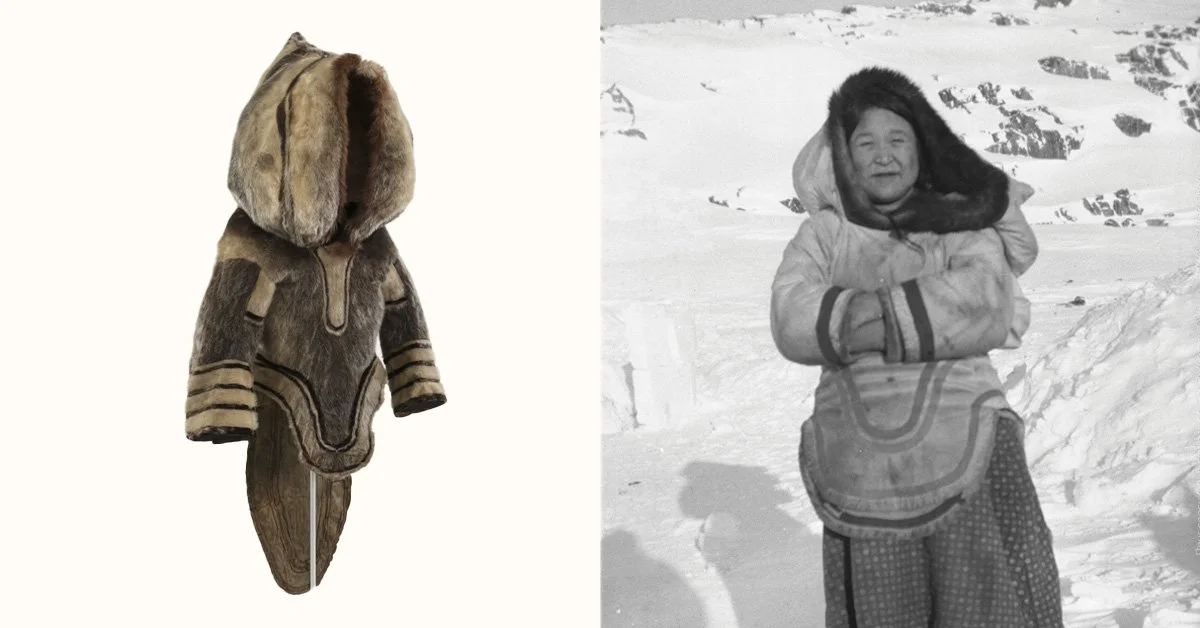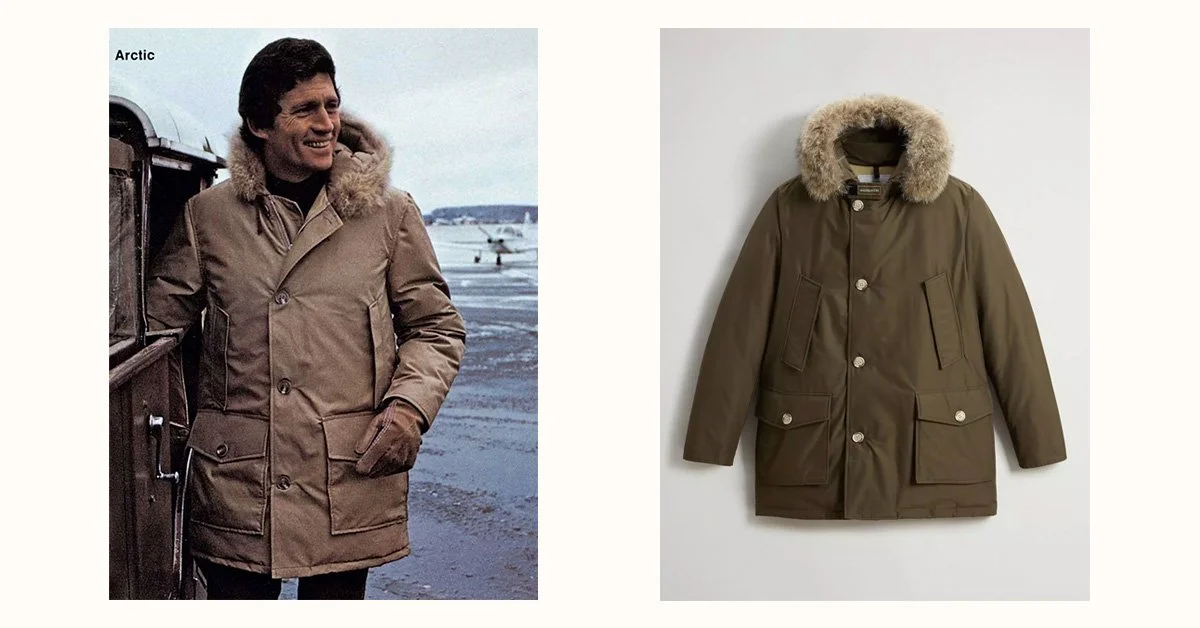History of Parka
If you live somewhere with temperatures colder than 15 degrees, chances are you’re familiar with the parka. Most people would describe it as a longer jacket with a hood and a few exterior pockets. However, many don’t know the history of this iconic garment or that the modern parka is quite different from its original version.
The parka was invented by the Inuit of the Canadian Arctic, who called it the "Amauti." Made from caribou skin and coated with fish oil, it kept them warm and dry in freezing conditions. The traditional amauti was more like what we know today as an anorak. It didn’t have an open front like the modern parkas developed since WWII. It was mainly worn by women because it had an extra hood-like pocket to keep their babies warm in the cold. While this baby-carrying pouch is no longer part of modern designs, the parka still has its signature large pockets. The name "parka" comes from the Nenets language of the Siberian people and it means "animal skin," referring to the material used in the original Inuit version.
Amauti - left (musee-mccord-stewart), right (historymuseum.ca)
The development of the parka can be traced back to Grenfell and other companies in England and the U.S. who made coats for explorers and scientists in harsh environments between the two world wars. The waterproof cotton versions of the amauti, created for Dr. Wilfred Grenfell’s medical mission to Newfoundland, likely inspired the modern parka.
During WWII, the U.S. Army was inspired by the ‘Amauti’ and used its design to create jackets for soldiers. The design was changed to suit the soldiers' needs, creating a version of the parka similar to the one we know today. These cold-resistant coats were ideal for pilots and soldiers in cold areas, with large pockets for storing ammunition, food, and medical supplies. The oversized shape fit easily over bulky uniforms.
As the war went on, the parka evolved. After the original B-9 Parka designed by Eddie Bauer, the N-3B Parka was introduced. The "Snorkel Parka" as they called it, had a zipper that went up to cover most of the soldier’s face. While it kept soldiers warm, the hood limited their hearing and vision, making them vulnerable to attacks.
During the Korean War, the Fishtail Parka was created (the most well-known versions are the M-48, M-51, and M-65). It was named after the split at the back, which resembled a fish tail. This split allowed soldiers to tie the ends around their legs for extra warmth in the cold climate. While we no longer need to tie our jackets, the fishtail remains one of the parka’s most iconic features.
Left: B-9 Parka - reproduction by Buzz Rickson’s
Right: Vintage 1951 M-51 Parka (raregearusa)
Mountaineering
The 1950s marked the Golden Age of Himalayan Mountaineering, as climbers successfully summited twelve of the world's fourteen 8000-meter peaks, starting with Annapurna in 1950. In 1953, a team of seven Americans and one British climber attempted the first ascent of K2, the world’s second-highest peak.
Three Americans from Seattle asked Eddie Bauer to create a warm, down-insulated parka for the expedition. Bauer and his team designed the Karakoram Parka, named after the mountain range where K2 is located. Expedition leader Charles Snead Houston praised it as “the finest cold-weather, high-altitude equipment I have ever seen.”
While the Third American Karakoram Expedition didn’t reach K2’s summit, they are admired for their teamwork and survival under catastrophic conditions. Their strong reputation and praise for Bauer’s parka established him as a leading expedition outfitter. His down-insulated gear was later used on historic climbs, including the first ascents of Gasherbrum I (1958), Masherbrum (1960), Antarctica’s Vinson Massif (1966), and the first American ascent of Mount Everest (1963).
Left: Vinage Eddie Bauer ad
Right: The 1953 American Expedition Team in their Kara Koram's (clutch-cafe)
Mainstream adaptation
In the 60s, after World War II and the Korean War, military parkas became available to civilians through Army Surplus stores. Styles like the M-51 and M-65 became popular, especially with the UK’s mod movement. Mods wore stylish clothes and Chelsea boots and the parka became a key part of their look. They used it to stay clean while riding their Vespas and made a bold statement with their signature style.
Modern versions
In 1972, another classic was born: the Woolrich Arctic Parka. It was created for a U.S. government project to build a natural gas pipeline from Alaska to North America, requiring clothing suitable for sub-zero temperatures. While today’s versions have an updated silhouette and down fill, the basic design has remained the same.
The original fabric used was 60/40 cross, valued for its water, wind and wear resistance, and widely popular in 1970s U.S. outdoor and workwear. The hood features coyote fur, chosen because it doesn’t freeze and was readily available due to culling in Pennsylvania. Other features include large buttons that are easy to use with gloves, a V-shaped "chevron stitch" inside, a fleece-lined hand warmer pocket on the front, and extra-large bottom pockets with gussets for added space.
Left: Vintage Woolrich ad (oipolloi)
Right: Woolrich Arctic Parka today - nothing has changed visually
Modern parkas are often lighter, with or without fur-lined hoods, and offer more flexibility for layering. New materials like Gore-Tex, developed in 1976, improved weather resistance and are today used in many different designs and for various purposes.
Many of these pioneering brands, like Eddie Bauer and Woolrich, are still around, but their products no longer match the quality they once had. These brands became symbols of innovation and excellence, but they compromised this legacy by closing local factories and moving production overseas to cut costs and boost profits.
Today, parkas are mostly seen as fashion statements, but some are still used for outdoor activities like mountaineering or snowboarding. Most new styles use the latest materials, but remakes of the original 1950s versions are still available. The most authentic reproductions can be found through "repro" brands like The Real McCoy’s and Buzz Rickson’s.
I’m not a fan of modern versions when it comes to casual dressing. The materials often have a plastic-like appearance and look too sporty, so I’d only wear them for outdoor activities. For daily wear, I prefer the timeless look of 1950s mountaineering jackets, like the Karakoram Parka, especially in orange or yellow. Their retro aesthetic works perfectly with most casual clothes. If you are looking for a quality made winter Parka, I made a list of the best quality winter parkas you can buy.
related articles









The Derby shoe we know today may have originally been designed as military footwear during the Napoleonic Wars. After nearly two centuries this shoe may not serve the same purpose as it once did, but it still plays a similar role in style.